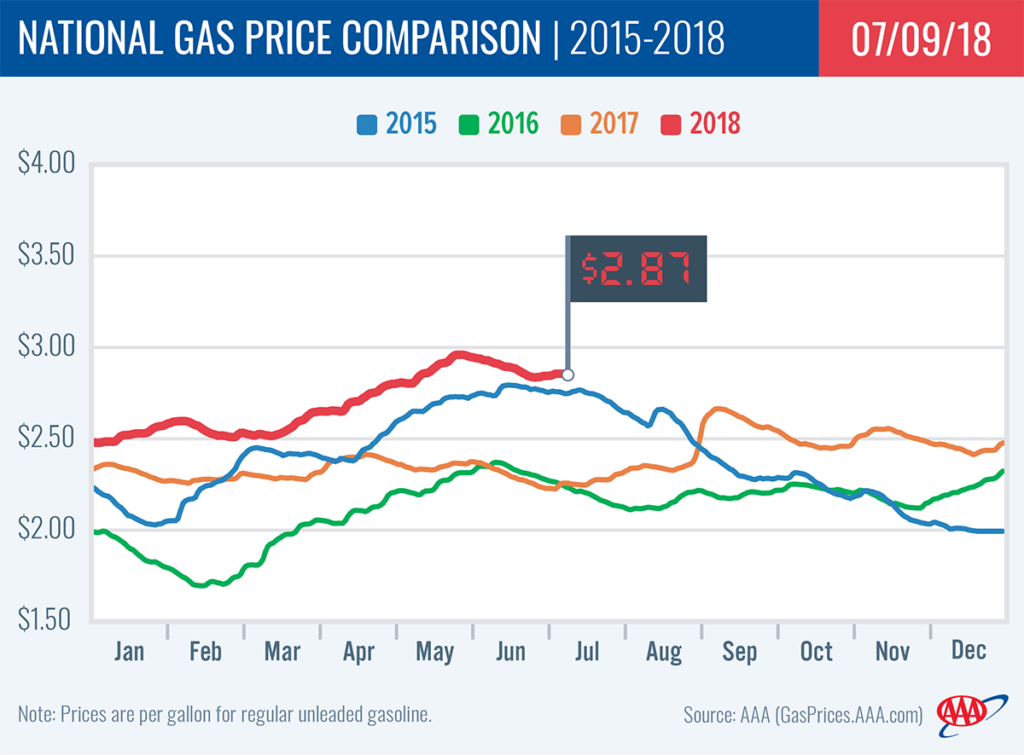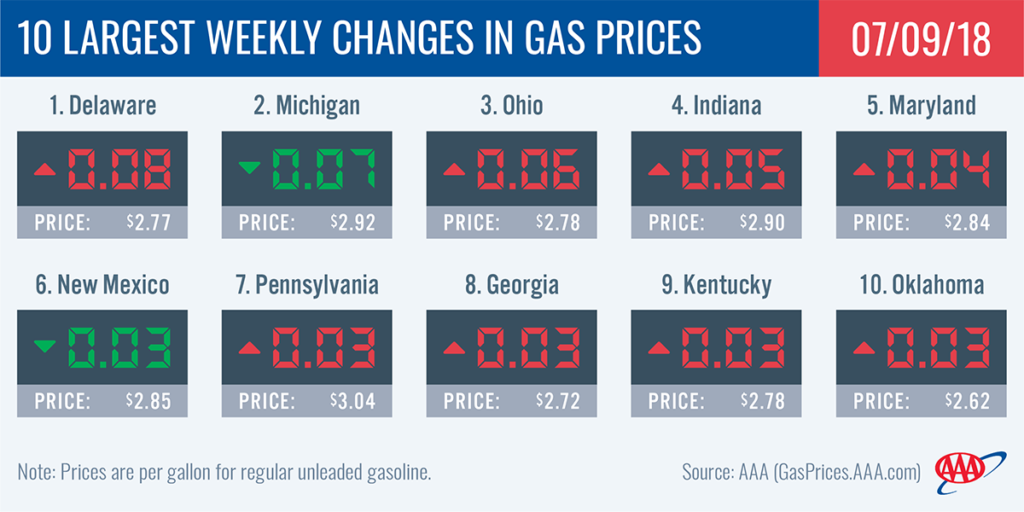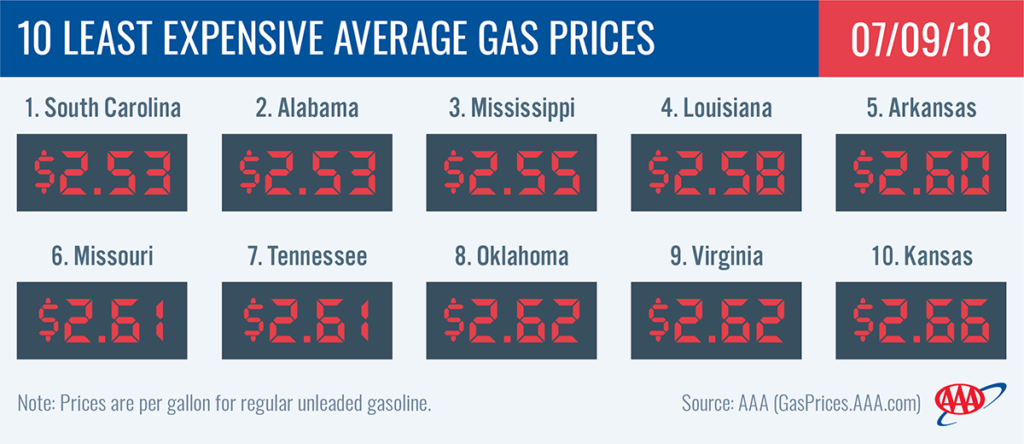The national gas price average is $2.87, which is a penny more expensive on the week. Pump prices in nearly 30 states are seeing a jump of as much as eight cents, a dozen states saw prices drop and another dozen states’ gas price averages remain stable from last Monday.
“Demand for gasoline this summer remains very strong week-over-week, driving gas prices higher alongside rising crude prices,” said Jeanette Casselano, AAA spokesperson. “Today motorists are seeing gas for $2.76 or more at 56 percent of gas stations across the country.”
Today’s gas price average is six-cents cheaper than last month, but 61-cents more expensive than at the same time last year.
Quick Stats
- The nation’s top 10 largest weekly changes are: Delaware (+8 cents), Michigan (-7 cents), Ohio (+6 cents), Indiana (+5 cents), Maryland (+4 cents), New Mexico (-3 cents), Pennsylvania (+3 cents), Georgia (+3 cents), Kentucky (+3 cents) and Oklahoma (+3 cents).
- The nation’s top 10 least expensive markets are: South Carolina ($2.53), Alabama ($2.53), Mississippi ($2.55), Louisiana ($2.58), Arkansas ($2.60), Missouri ($2.61), Tennessee ($2.61), Oklahoma ($2.62), Virginia ($2.62) and Kansas ($2.66).
West Coast
Pump prices in the West Coast region are among the most expensive in the country: Hawaii ($3.73), California ($3.66), Washington ($3.44), Alaska ($3.40), Oregon (3.32), Nevada ($3.24) and Arizona ($3.00). Most prices in the region have declined on the week, with Arizona (-2 cents) leading the group.
Inventories of gasoline in the region fell for a third consecutive week, according to the Energy Information Administration’s (EIA) petroleum status report for the week ending on June 29. Dropping by nearly 150,000 bbl, total inventories now sit at 30.5 million bbl. However, inventories are approximately 2.2 million bbl higher than they were at this point last summer, which will likely help prices stabilize if there are any major supply disruptions in the region this week.
Great Lakes and Central
Gas prices are volatile on the week in the Great Lakes and Central region with gas prices anywhere from seven cents cheaper to six cents more expensive. A handful of states’ gas price averages remain stable on the week. Four states from these regions land on this week’s largest gas price changes list: Michigan (-7 cents), Ohio (+6 cents), Indiana (+5 cents) and Kentucky (+3 cents).
At $2.95, Illinois has the most expensive gas prices in the region followed by Michigan ($2.92). At $2.61, Missouri is the cheapest.
Gasoline inventories built for a fourth week in the region. Adding nearly 440,000 bbl, total inventories sit at 53.7 million bbl. According to the EIA, levels are similar to this time last year.
South and Southeast
States in the South and Southeast are seeing more expensive gas prices on the week, with a jump of as much as three cents in Georgia and Oklahoma. New Mexico (-3 cents) and Florida (-1 cent) were the only states to see a decline at the pump. South Carolina ($2.53) continues to tout the cheapest gas price average in the country and the region.
With gas prices nearly a dime or more cheaper than last month, New Mexico (-13 cents), Texas (-10 cents), Florida (-9 cents) and Alabama (-9 cents) land on the top 10 states with the largest month-over-month changes in pump prices.
Gasoline inventories drew down by nearly 500,000 bbl on the week. Even with the dip, total inventories register close to 83 million bbl, which is on par with levels year-over-year and are keeping prices somewhat stable.
Mid-Atlantic and Northeast
Delaware (+8 cents) is seeing the largest jump at the pump of any state in the Mid-Atlantic and Northeast region on the week. There were no pump price declines, but a few states saw gas prices remain stable: Wisconsin ($2.81), Vermont ($2.92) and Massachusetts ($2.91).
Prices compared to one year ago are as much as 66-cents more expensive with three states landing on the top 10 list of biggest year-over-year changes: Connecticut (+66 cents), Rhode Island (+64 cents) and Massachusetts (+63 cents).
Following last week’s 1.2 million bbl build, the region saw the largest draw of any region in the country at 1.6 million bbl this week, according to EIA data. The Mid-Atlantic and Northeast region inventory level now measures 65.5 million bbl, the lowest level recorded the region in the month of June and a potential factor driving prices this week.
Rockies
Gas prices are mostly cheaper on the week among states in the Rockies: Idaho (-2 cents), Utah (-2 cents) and Wyoming (-1 cent). Colorado’s ($2.85) and Montana’s ($2.93) average held steady the last seven days.
At 7.3 million bbl, total gasoline inventories measure at the highest level in the region since late April. On the week, inventories built by nearly 239,000 bbl and register 363,000 bbl ahead of this time last year, which is an indicator that refinery runs are returning to a normal schedule following a long maintenance season.
Oil market dynamics
At the close of Friday’s formal trading session on the NYMEX, WTI increased 86 cents to settle at $73.80. Crude prices trended lower last week following EIA’s report that showed U.S. crude oil inventories increased by a total of 1.3 million bbl last week. It was the first time in three weeks that the U.S. has seen a build in inventories, which typically sees drawdowns throughout the summer. At 417.9 million bbl, crude inventories in the U.S. are 85 million bbl lower than they were at this time last year. The surprise build in total crude stocks gave market observers pause amid a slew of other factors influencing the oil market, including increasing geopolitical factors – in Iran, Libya, and Venezuela – potentially destabilizing global supply. Moving into this week, market observers will watch these factors to determine their impact on supply. If it appears that supply could be reduced amid high global crude demand, oil prices may increase.
In related news, the U.S. oil rig count increased by five last week, according to Baker Hughes, Inc., bringing the total number of rigs to 863. When compared to last year’s count at this time, there are 100 more rigs presently.
Motorists can find current gas prices along their route with the free AAA Mobile app for iPhone, iPad and Android. The app can also be used to map a route, find discounts, book a hotel and access AAA roadside assistance. Learn more at AAA.com/mobile.



